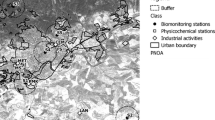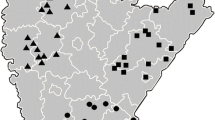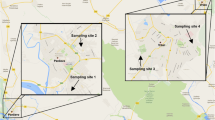Abstract
Experiment was carried out using 12 colonies of honey bees bred in hives located near an extraurban crossroad. We analyzed the Pb, Cd and Zn deposited on the bee's surfaces and the heavy metal accumulation in the foragers, dead bees, honey products and some environmental markers during nine weeks of the experiment. Results showed a large amount of Zn and Cd on the bee's surface as a consequence of atmospheric fallout, whereas Pb seems to be either water-extractable and/or likely accumulated in the body of the insect. Dead bees expelled from the hives displayed a progressive accumulation of all heavy metals during the experimental period. Royal jelly and honey contained large amounts of heavy metals. In particular, we found a linear relationship between Cd in the honey and that found in flowers of Trifolium pratense L. Results obtained suggested that honey bee products and the examined environmental markers may be considered useful parameters to assess the presence of environmental contaminants, whereas the measurements of heavy metals in the dead bees may be considered a suitable tool also to verify a possible dynamics of accumulation of pollutants.
Similar content being viewed by others
References
Accorti, M., Guarcini, R., Modi, G. and Persano-Oddo, L.: 1990, ‘Urban Pollution and Honey Bees’, Apicoltura 6, 43–45.
Barbina-Taccheo, M., De Paoli, M., Mondini, R., Pezzoni, A., Barbattini, R., Greatti, M., Chiesa, F. and D'Agaro, M.: 1993, ‘Honey Bee as Indicator of Agricoltural Pollution’, in: Proc. IX Symposium of Pesticide Chem., Degradation and Mobility of Xenobiotics, pp. 573–579.
Bromenshenk, J. J. and Carlson, S. R.: 1985, ‘Pollution Monitoring of Pugget Sound with Honey Bees’, Science 227, 632–634.
Bromenshenk, J. J., Gudatis, J. L., Cronn, R. C. and Olbu, G. J.: 1988, ‘Uptake and Impact of Heavy Metals to the Honey Bees’, Am. Bee J. 128, 800–801.
Celli, G.: 1984, ‘L'ape Come Insetto Test della Salute di un Territorio’, Apicolt. Mod. 75, 133–140.
Celli, G., Porrini, C., Frediani, D. and Pinzauti, M.: 1987, ‘Api e Piombo in Città’, Atti Convegno AICS ‘Salute del Territorio: Qualità dell'Aria, Indicatori Biologici, Api e Piante’, Florence, May 1987, pp. 11–45.
Cesco, S., Barbattini, R. and Agabiti, M.F.: 1994, ‘Honey Bees and Bee Products as Possible Indicators of Cd and Pb Environmental Pollution: an Experience of Biological Monitoring in Portogruaro City (Venice, Italy)’, Apicoltura 9, 103–118.
Crane, E.: 1975, ‘Honey: a Comprehensive Survey’, Int. Bee Research Association, London.
Freedman, B. and Hutchinson, T. C.: 1981, ‘Sources of Metal and Elemental Contamination of Terrestrial Environments’, in: Lepp, N. W. (ed.), Effect of Heavy Metal Pollution on Plants, Applied Science Publishers, London/New Jersey, pp. 35–94.
Greatti, M., Barbattini, R., D'Agaro, M. and Nazzi, F.: 1994, ‘Effect of Time on the Efficiency of Different Traps for Collecting Dead Honey Bees’, Apicoltura 9, 67–72.
Jones, K. B.: 1987, ‘Honey as an Indicator of Heavy Metal Contamination’, Water, Air, and Soil Pollution 33, 179–189.
Kabata-Pendias, A. and Pendias, H.: 1992, Trace Elements in Soils and Plants, CRC Press.
Marchetti, S., Chiesa, F. and D'Agaro, M.: 1987, ‘Bee Mortality Following Treatment with Perizin in Colonies of Apis mellifera carnica and Apis mellifera ligustica’, Apicoltura 3, 157–172.
Otto, K. and Jekat, F.: 1997, ‘Experimental Investigation on the Contamination of a Food (Honey) with Residues of Lead, Zinc, Cadmium, Ervahrungen Umschau 24, 107–109.
Robson, A. D.: 1993, Zn in Soils and Plants, Kluwer Acad. Publ., London.
Tansley, A. G.: 1935, ‘The Use and Abuse of Vegetation Concepts and Terms’, Ecology, 16, 284–307.
Verkleij, J. A. C. and Schat, H.: 1990, ‘Mechanisms of Metal Tolerance in Higher Plants’, in: Shaw, A. J. (ed.), Heavy Metal Tolerance in Plants, CRC Press, pp. 180–193.
Wallwork-Barber, M. K., Ferenbauch, R. W. and Gladney, E. S.: 1982, ‘The Use of Honey Bees as Monitors of Environmental Pollution’, Am. Bee J. 122, 770–772.
Author information
Authors and Affiliations
Rights and permissions
About this article
Cite this article
Leita, L., Muhlbachova, G., Cesco, S. et al. Investigation of the use of honey bees and honey bee products to assess heavy metals contamination. Environ Monit Assess 43, 1–9 (1996). https://doi.org/10.1007/BF00399566
Issue Date:
DOI: https://doi.org/10.1007/BF00399566




